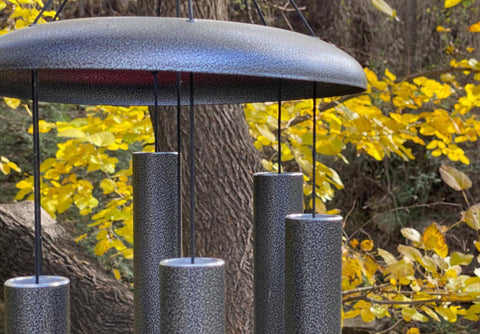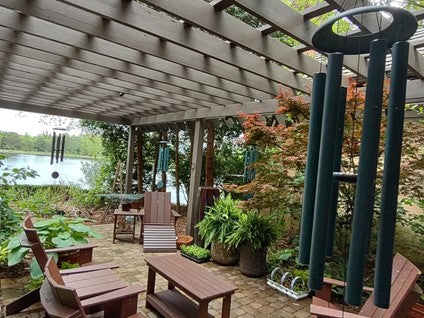
When you’re choosing a wind chime, how they look is important, but what REALLY makes a wind chime extraordinary is the sound it makes.
Have you heard wind chimes that sound tinny or harsh? Not many people find that sound appealing! But Wind River chimes are not your typical wind chimes. We’ve heard countless stories from former wind-chime-haters who have been converted by the rich, warm tones of a Wind River chime.
What is it that sets our wind chimes apart from all the others? It’s something we call the science of sound, and it’s what guides the crafting of our wind chimes. A Wind River chime is actually a musical instrument powered by the wind.
Read on to find out why Wind River chimes are different from other chimes:
1) Wind Chime Materials
Aluminum Alloy: Just like a violin craftsperson looks for the best wood to make a violin, we look for the best materials to make a wind chime that has resonance and durability. From our Classic to our Premier wind chimes, the Wind River difference all begins with the aluminum alloy that we use.
Aluminum makes our wind chimes lightweight and weather resistant. But when it comes to pitch and resonance, each alloy has its own unique characteristics. Through years of testing and engineering, we’ve identified the aluminum alloy that creates exceptional tone and sound quality—and we use it in every chime.
String and Stringing: We’ve also identified the best string and stringing method to use. Every Wind River chime uses heavy-duty, braided nylon cording that’s treated to be weather and UV resistant.
Unlike other chimes on the market, our Premier and Deluxe chimes are hung from a single string tied to a central, interior pin. Using centrally pinned tubes in a wind chime is unique, and elevates the resonance and overall quality of these chime tones, making them more sophisticated instruments.
Our Classic chimes are strung together with cording that runs through holes drilled in each tube, creating a zig-zag pattern. This stringing style allows for a light, bright, cheerful tone, and is probably the most common among wind chimes on the market. But, because of the quality of materials and the precision of musical tuning in every Wind River chime, there is a clear difference of tone and durability.
Striker: The other contributor to a Wind River chime’s unmatched sound is the striker.
Our Premier wind chimes use a soft striker made out of ultra-high-density polymer, which gives each chime a gentle, soothing reverberation. But strikers must also be heavy enough to create a clean, crisp note upon impact. To create a soft striker with a lot of mass, we mold ultra-high-density polymer into a curved elliptical shape. It’s a detail that makes a Wind River chime truly sing.
Our Deluxe and Classic chimes use a wooden striker, made out of California Redwood. In addition to its exceptional beauty, redwood is sustainable, weather-resistant and its soft texture creates a mellow sound as the wooden striker rings each chime.
2) Wind Chime Craftsmanship
Before a Wind River chime is assembled, we test the tone, resonance and pitch of each tube by hand.
At Wind River, we believe that ordered sound orders us, so it’s important that every chime is organized into a classical musical key. The fine materials we use enable us to be absolutely precise with the harmony of each chime, and this is the main distinction that separates Wind River chimes from the rest.
No random or tinkly tones! Pure harmony… inspiring your harmony.
3) Wind Chime Sustainability
Wind River is passionate about shaping environments for the better, which includes taking care of our planet and Mother Nature who make our chimes sing.
We source all our materials from within the United States, including native hardwood from Pennsylvania, durable redwood from California, string and pipe from New York, Georgia and Florida, and metal components from all over the Midwest.
We make every chime to last, but if it needs it, we offer repairs on every chime we manufacture. We also recycle all scrap aluminum, as well as all the cardboard that goes through our buildings.
If you typically don’t like the sound of wind chimes, we hope you’ll give Wind River chimes a listen -- you can hear a sound clip of every chime right on this website.
Let the sound of our chimes explain their difference to you now…


